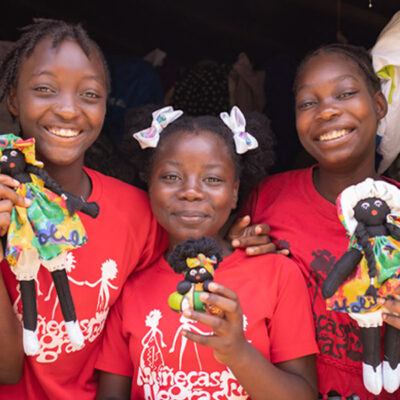
How hand-stitched dolls are changing Black women’s lives in the Dominican Republic
Posts


Women Reaching New Horizons: Reflections from Guatemala
I recently met with Maria Auxiliadora Gualim López, the founder and general coordinator of AJWS grantee Nuevo Horizonte (New Horizons) in Chisec in the Guatemalan department of Alta Vera Paz.
Read MoreStories

Stitching together a strong sense of identity
The Muñecas Negras initiative brings together women and girls, largely from communities of Haitian descent, in rural areas across the Dominican Republic — giving them a safe space to connect, take pride in their identity and learn about their history, all while creating dolls that share their skin color. Below, step into Batey Carmona to …
Read More
Across two generations — a family transformed
It was Yanilda Juan, 23, who brought her family to Muñecas Negras. Today, her sisters and their daughters joined: seven Juan women in all. “This project doesn’t just teach us to stitch dolls. It teaches us to love ourselves, our roots, our ancestors, our hair, our skin. To understand that everything we have is gold, …
Read More
Kika’s journey from early marriage to college student
Juanita ‘Kika’ Antelis Juan is the oldest Juan sister, at 26. For Kika, Muñecas Negras inspired an extraordinary change in her life. She grew up in a family of 10 and was married when she turned 15 (In the Dominican Republic, marriage is often forced upon adolescent girls by families struggling financially, to lessen her …
Read MoreDvar Tzedek
Pinchas
A shocking and inspiring episode in Parashat Pinchas occurs when the five daughters of Zelophechad stand up to Moses, Aaron and Elazar and demand to inherit their father’s property, in the absence of any sons. This courageous act, which challenges the assumption that tribal land can be passed on only from fathers to sons, seems to leave Moses speechless and moved, and he takes their claim to God.
Read MoreShlach
You likely know that our ancestors wandered the wilderness for 40 years until they entered the Promised Land. You may find it surprising, though, that the ancient Israelites actually arrived at the border of the Land of Israel only two years after the Exodus. The other 38 years of wandering weren’t a long journey to the land; they were the consequence of ill-fated events that took place during Parashat Shlach.
Read MoreNaso
Torah—with its rich narratives and poetry, glimpses of the Divine and profound wisdom—is a text we turn to for inspiration, intellectual stimulation and meaning. Yet there are moments in the Bible when culturally located prejudices come to the fore and the reader is left struggling with the tension between timeless writing and context-bound oppression. One such moment is the law of the sotah—or wayward woman—found in Parashat Naso.
Read MoreBechukotai
Walking—putting one foot after the other—is, for many of us, our most basic vehicle for navigating the world. Yet we probably don’t put much thought into it. We’re more concerned with where we’re going than how we’re getting there; and unless we’re on a hike, we rarely think of walking as an end in itself, or count it among our blessings.
Read MoreTazria
Parashat Tazria opens with a passage that makes many contemporary readers bristle at its seemingly obvious gender discrimination. Describing a woman who has just given birth, the text relates that not only is she impure, but the length of her impurity doubles for a daughter in contrast to a son. While the gender-based distinctions in the text may arouse anger or confusion, they provide an opportunity to reflect on the topic of gender and they may also offer insights into how gender plays a role in our own lives and in the lives of people around the world.
Read More